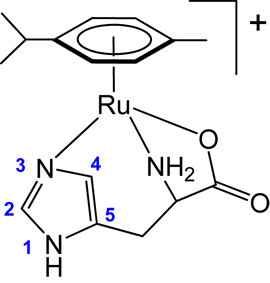Synthesis, characterization and cytotoxicity of (η6-p-Me-C6H4-iPr)-Ruthenium II) complexes of α-amino acids and nucleotides
(F. A. Egbewande, L. Paul, J. Furrer)
Once inside the cell, anticancer metal complexes (Pt, Ru,…) form active species whose structures, reactivity and cytotoxicity are only poorly known and understood. As the amount of proteins, peptides or single amino acids is substantial in the cytosol, formation of stable N,O; S,N,O or N,N,O chelates represents conceivable structures. Therefore, it is also likely that these chelates formed in the cells may be responsible, at least partly, for the observed high cytotoxicity of the metal complexes. For instance, it is plausible that NAMI-A, KP1019, the RAPTA complexes family, and RM175, once inside the cell, react with proteins and disassemble to form such chelates, knowing that their mode of action and final targets are still poorly understood. We have synthesized various chelates with the general formula [(p-cymene)Ru(AA)]+, AA = amino acid, and assessed their cytotoxicity in conditions close to the physiological conditions of the cytosol.


